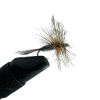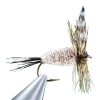The Classic Dry Fly Patterns, are mostly used for fishing for Trout. Most of these flies are traditional fly patterns and have been around for a long time. These are the Dry Fly Patterns that you should have in your fly box all of the time. These Dry Fly Patterns are essential because they will almost always catch fish in just about any waters. These Classic Dry Fly Patterns are also the ones that you use when you are trying to figure out which fly to use on new waters.
Some of the Dry Fly patterns are from as far back as the 15th century. All of these patterns are tied with wings made of material that makes their profile on the water wider and allows them to float on the surface of the water. Dry Fly floatation is also increased by the use of chemical products called Floatants.
Dry fishing fly patterns are used when there are bugs flying around above the surface of the water. The flies that are hatching will depend upon where you are, what time of day it is, what time of year it is, and how dry the air is. All you have to do is choose a Dry fly that imitates the bugs that are flying around.
This is called matching the hatch. If you can, find a fly that is close in size, color and shape of the hatch. Sometimes matching the hatch is very difficult, especially with regard to size. Sometimes it is enough to match the general color of the hatch. Other times you have to match the color and size of the natural flies and you have to have the right presentation.
If you are real lucky it won’t matter. Any fly will work.
When there is no hatch a Dry Fly can be used as a strike indicator. Tie a wet fly on the end of the line and tie a Dry fly about 2-3 feet up the line. Sometimes you will get a surprise and the fish will go after the Indicator fly instead of the fly at the end of the line.
Your Classic Dry Fly patterns will vary depending on where you are fishing and by the time of year. I have seen many traveling fishermen that carry separate fly boxes for each area that they fish. Or they have an Eastern section and a Western section in their fly box. I have also seen fishermen that organize their fly boxes by targeted species.
Myself I am lucky if I can find a specific fly in the several boxes of flies that I have and even luckier if I can remember the name of the fly. I know I have the Essentials in the box it is just that sometimes they hide. The problem gets bigger each time I put flies back in the box. I usually don’t pay any attention to which box I put the flies back in to.
In my box of Classic Dry Flies I like to have some smaller flies that provide a range of contrast like for instance a Black Gnat for dark and a White Miller for Light, and then in the middle I like to carry an Adams or Mosquito. Then I like to carry some larger meatier flies like a Stimulator, or Hare’s Ear Parachute. For some added color I throw in a set of Royal Coachman, Royal Wulff, Female Adams, Green Humpy and Royal Humpy.
When I am stocking up on my Classic Dry Fly selection I usually choose flies in the middle of the common sizes available and then choose a couple of flies that are at the small end of the fly sizes available and a couple at the large end of the sizes available. This gives me a wide selection of flies to match the sizes of the various fly hatches throughout the season.
Some of the Classic Dry Dry Fly Patterns you will want to stock up on include:
 ADAM’S
ADAM’S ADAM’S HUMPY
ADAM’S HUMPY